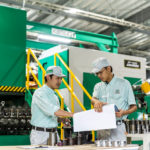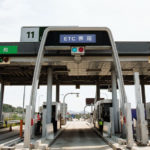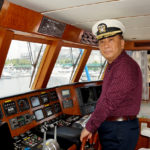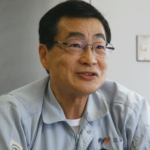Panasonic has marked its centenary with the establishment of a brand new design center in Kyoto. Katayama Osamu reports.
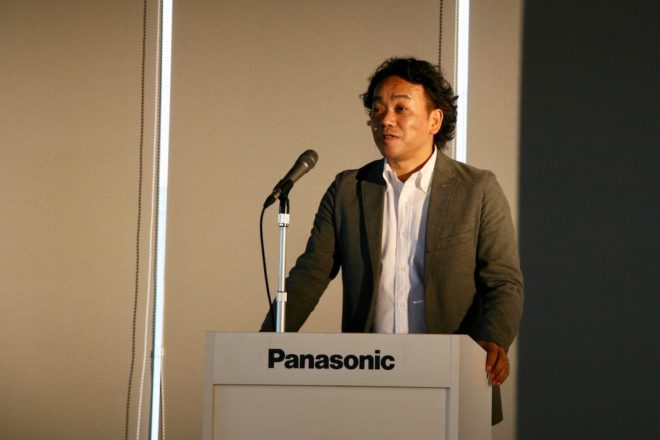
Usui Shigeo, director of Panasonic’s Appliances Company Design Center
KATAYAMA OSAMU PHOTO
When we think about the design of home electric appliances, we tend to picture the things that we use, like refrigerators and washing machines, and think about how they look; in other words, product design. Today, however, design is not just about things, but also services, solutions, businesses, communities and solutions to social issues. The role of design has expanded.
“These days,” says Usui Shigeo, director of the Appliances Company Design Center of Panasonic Corporation, “if design does not also involve aesthetic values and experiences, it is considered to be unfinished.”
This April, Panasonic established its new design headquarters in Kyoto, called Panasonic Design Kyoto. Panasonic’s division for designing home electric appliances had previously been separated into Kadoma City (Osaka Prefecture) for black goods and Kusatsu City (Shiga Prefecture) for white goods. The division has now been centralized in Kyoto.
“One of the reasons we established our headquarters in Kyoto was because of the city’s strong creativity in continuing to produce the kind of Japanese values and aesthetics people have associated with the ‘capital of Japanese culture’ for many years,” says Usui.
Reflecting Kyoto’s nominal status as the “capital of Japanese culture,” the Agency for Cultural Affairs will be relocated from Tokyo to Kyoto in 2019. Kyoto is a global brand city, and excellent foreign designers might need no persuading to work in Japan’s former capital.
With the establishment of Panasonic Design Kyoto, Panasonic intends to transform itself from a group that designs only home electric appliances to a group that designs experiences.
To undertake a wide variety of design incorporating aesthetic values and experience as well as product design, Panasonic needs specialists in many fields, including design strategy, information gathering, analysis, colors and materials.
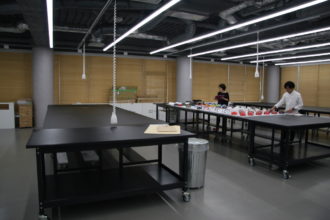
A workspace at Panasonic’s new nine-story design headquarters in Kyoto
KATAYAMA OSAMU PHOTO
For European design companies, for example, teams of specialists in individual areas usually implement projects. For Japanese design companies, in contrast, a specialist usually deals with a product singlehandedly, and people have not paid much attention to drawing up strategies or analyzing information.
This was also the case with Panasonic. The Appliances Company Design Center has a total of 200 employees at bases in Kyoto, Tokyo, Shanghai, Hong Kong, Kuala Lumpur, London and Newark, USA. Some 150 employees work in Kyoto, and more than 100 of those employees are product designers.
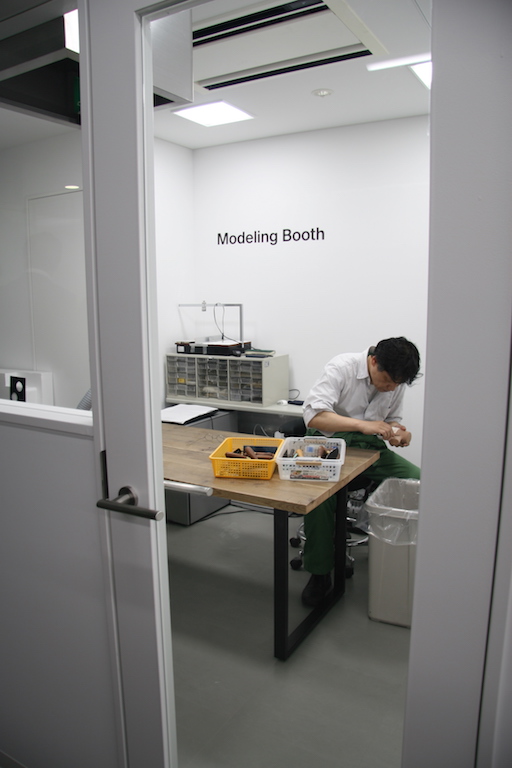
A craftsman at work in the Modeling Booth at Panasonic Design Kyoto
KATAYAMA OSAMU PHOTO
Usui says, “For human resources, to promote diversity, we significantly strengthened the functions we had lacked before by inviting specialists in CMF strategy for colors and texture in the area of sports apparel brands and transferring engineers and researchers from other sections of the company to the design section.” But Panasonic is still short of researchers and strategists.
Panasonic formed a London-based team of specialists called FLUX for designing home electric appliances; that is, an organization of specialists. FLUX will gather insights from the European design scene that will help to inform Panasonic’s design process. Ikeda Takehiro, a design strategist who was invited to join Panasonic in April 2018, is the director of Panasonic FLUX. At 37 years of age, he is a young leader.
After obtaining a master’s degree in strategy design at Aalto University in Helsinki, Finland, Ikeda formulated design strategies for global corporations such as Unilever, Samsung, Denso and Hitachi, drawing up brand visions and proposing product innovations for eleven years at Seymourpowell, a British creative consulting firm. Ikeda therefore has broad expertise in design strategy. It was Ikeda who proposed that Panasonic establish FLUX.
Why is Ikeda fascinated with Panasonic? Ikeda says, “I find it fulfilling to work for the company because Panasonic is a brand company that has hardware at the intersection of every aspect of life, which makes it a brand company that is eligible to speak about life culture.”
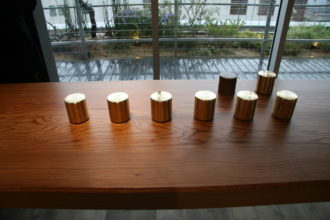
Samples of Panasonic’s handheld speakers Kyo-zutsu, manufactured in collaboration with tea canister brand Kaikado. The speakers are one of numerous products designed through Kyoto KADEN Lab., a project engaging a variety of traditional industries in Kyoto.
KATAYAMA OSAMU PHOTO
Panasonic Design Kyoto will serve as an arena for open innovation, taking inspiration from co-working spaces around the world including those listed above. Panasonic Design Kyoto has established a partnership with the Graduate School of Engineering of Kyoto University, which focuses on design studies. In 2015 Panasonic Design Kyoto launched Kyoto KADEN Lab., a collaborative project with traditional industries in Kyoto. Kyo-zutsu, a product developed under the project in collaboration with the long-established tea canister brand Kaikado, will be commercialized in the spring of 2019. Kyo-zutsu is a sleek handheld speaker that turns on when its metal lid is lifted.
Panasonic is seeking to circulate new Japanese home electric appliance designs from the ancient city of Kyoto. Ikeda says, “When people working for Japanese companies hear about Apple and Dyson, they feel that these companies are distant. But they can relate to and imitate Panasonic. A change in Panasonic means change in multiple companies.”
Ikeda is extremely ambitious. Panasonic is expected to bring about major changes in the design of a company which this year celebrates its 100th anniversary in business.
KATAYAMA Osamu is an economics journalist and representative of K-Office. He has published extensively, including Sumato kakumei de seicho suru Nihon keizai (Growing the Japanese Economy with the Smart Revolution), and Naze Za Puremiamu Morutsu ha uretsuzukeru noka? (Why does The Premium Malt’s beer sell so well?). Recent publications include Samsun kuraishisu (The Samsung Crisis).
Showrooms at the Inn
Panasonic recently entered the private lodging business. Katayama Osamu investigates why.
The New Private Lodging Business Act regulating short-term stays at privately owned homes for a fee went into effect on June 15, 2018. Immediately however there was confusion, with an intermediary website deleting about 40,000 unreported private lodgings. One month after the act went into effect, only 5,000 minpaku properties had been registered with prefectural government offices.
The New Private Lodging Business Act set an upper limit of 180 business days on private rental accommodation houses excluding those in National Strategic Special Zones, such as Ota Ward in Tokyo, part of Osaka Prefecture and Kitakyushu City. Real estate properties in urban areas whose rents are high have difficulty being profitable, which prevents the number of registered properties from increasing. It is clear, however, that there is a shortage of accommodation facilities for achieving the government’s goal of attracting 40 million inbound tourists by 2020 and 60 million inbound tourists by 2030.
The media reported that Panasonic entered the private lodging business in June 2018. Many people may wonder why. What will Panasonic do?
Under Eco Solutions Company, one of the in-house companies of Panasonic, is Panasonic Homes Co., which deals with order housing, housing complexes, apartment houses and renovations. Panasonic made PanaHome a subsidiary in October 2017 and renamed it Panasonic Homes Co. in April 2018.
Panasonic Homes has engaged in the land utilization business for more than fifty years. Panasonic Homes proposes rental housing and housing with shops to land owners and contracts to build houses. In addition, Panasonic Homes has a scheme of building nursing care, medical and welfare facilities, such as housing for elderly people and child-rearing facilities, leasing them, outsourcing their management and paying rent to land owners.
Panasonic Homes applies this scheme to the private lodging business. Panasonic Homes builds private lodging facilities, rents them from the owners and outsources their management to Hyakusenrenma, Inc., and SQUEEZE, Inc. Panasonic Homes receives about 10% of the lodging fees. Panasonic Homes aims to receive an order of 5 billion yen for ten houses in Tokyo and Osaka in 2018.
Will this project be profitable? In fact, the private lodging business that Panasonic Homes deals with does not have the upper limit of 180 business days.
The revised Hotel Business Act, which was enforced at the same time as the New Private Lodging Business Act, integrated the types of businesses that had been classified into inn management and hotel management into inn and hotel management. Deregulation also enabled inns and hotels to be run from a room with no need to provide a reception desk, and with identification by IT.
Panasonic focused on this point. That is, Panasonic will participate in the private lodging business of accommodation facilities to which the revised Hotel Business Act is applicable, not the New Private Lodging Business Act. This is free from the upper limit of 180 business days, and simple lodging houses can operate without a reception desk. In addition, Panasonic also plans to handle the private lodging business in National Strategic Special Zones that do not have the upper limit of business days.
With the declining birthrate and aging population, the number of construction projects of detached houses will shrink from now on. On the other hand, there is still demand for multi-layered industrial houses in urban areas, into which the population continues to flow. Private rental accommodation facilities are among them. Panasonic Homes also has a technique of using rigid Ramen steel frames to achieve buildings up to nine-stories tall, the tallest such premises in Japan.
In Minowa, Taito Ward, Tokyo, there is a facility managed by Panasonic Homes that began operating as a hotel regulated by the Hotel Business Act in April 2018. At a glance, it appears to be a rental house or an apartment building. The facility has eighteen rooms with a living room and a kitchen, ranging from 25 square meters to 40 square meters. Their prices change, but the cost is around 20,000 yen for a one-night stay in a room. If four people rent a room, they each pay 5,000 yen. It is so clean and stylish that it is far removed from the image of staying in a private lodging facility.
Private lodging facilities can work as Panasonic’s showrooms, with televisions, washing machines, home electric appliances for cooking and home electric appliances for beauty treatment as well as housing equipment manufactured by Panasonic, such as kitchens and toilets. Many foreign tourists buy home electric appliances in Japan, so it is a bright idea that makes it possible to kill two birds with one stone.
Will the private lodging business become a new source of profit for Panasonic? Undoubtedly, there is demand. Panasonic’s business development from now on is worth paying attention to, in addition to the synergetic effects on housing equipment and home electric appliances.
KATAYAMA Osamu is an economics journalist and representative of K-Office. He has published extensively, including Sumato kakumei de seicho suru Nihon keizai (Growing the Japanese Economy with the Smart Revolution), and Naze Za Puremiamu Morutsu ha uretsuzukeru noka? (Why does The Premium Malt’s beer sell so well?). Recent publications include Samsun kuraishisu (The Samsung Crisis).


